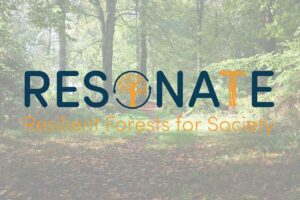ICF Associate Member, Nicholas Hill, took on an exciting work placement in Canada as part of his 2016 Prince of Wales Forest Leadership Award. In his latest blog for ICF, Nicholas takes us through the diverse forestry activities of Algonquin Provincial Park.
Algonquin Provincial Park is a multi-use forest. It is an esteemed setting for various recreational activities, a traditional hunting ground of multiple groups of aboriginal peoples, it has and continues to be the subject of some of Canada’s most famous landscape artists and it is home to a rich array of wildlife. The park also provides a substantial annual output of timber and in doing so sustains dependent local industries and jobs. Balancing social, environmental and economic factors is the foundation of all sustainable forest management and a constant consideration during daily forestry activities in the UK. However a stark difference in this case and element which takes a British forester some time to adjust to, is the vast special scale at which it is done here in Algonquin Provincial Park.
The park is 763,555 ha in total, which when converted to our common measuring scale is around 2/5 the size of Wales. Around 35% of the park interior is dedicated wilderness and nature reserves, from which timber harvesting is excluded. Outside of the wilderness areas further exclusions and modified operational zones are arranged as buffers around ecologically sensitive areas, such as watercourses (30 m exclusion) and habitat for various protected flora and fauna (spatially teared seasonal, silvicultural and operational restrictions). With such areas and water bodies accounted for around 50% of the park is subject to rotational timber harvests.
Moose antlers, wolf prints and seedy bear scat. Evidence of Algonquin beasts which prove to be far more elusive to the camera in person.
Despite being originally established as a ‘logging reserve’ in 1893 to protect the timber resource from encroaching conversion to agricultural land, forest management within Algonquin Provincial Park has been a subject of some discontent as park user groups grow and diversify. Being one of only two Provincial or National parks in Canada to facilitate commercial timber extraction, some local conservation groups and tourism reliant businesses grew concerned about negative impacts. Such criticism contributed to the formation of the Algonquin Forestry Authority (AFA) in 1974, a Crown agency which is responsible for the sustainable management of harvested areas within the park.
Today around 95% of harvested areas are managed under various continuous cover forestry systems. Broadleaf stands are selectively harvested to create irregular forest structures, with different age cohorts represented throughout. This replicates single tree fall disturbances and allows space for regeneration. In conifer stands uniform shelterwood systems are implemented to recreate the impacts of wildfire, a natural and common ecological process in such forest types that has long since been suppressed by man. Such efforts to imitate natural disturbances through harvesting has resulted in such areas being arguably closer to a theoretical natural structure and species composition of the region. As dedicated wilderness areas continue to succeed to mature shade tolerant tree species, harvested areas become vital in their ability to provide habitat for light demanding pioneer species and their dependent wildlife.
A seeding cut as part of the AFA’s shelterwood rotation promoting regeneration of otherwise fire dependent pine species. Retained trees are selected for good form, vigour and to a spacing which varies with light demands of target species. Mineral soils are exposed through scarification with barrels and chains towed behind skidders.
An abandoned beaver Pond. Beaver rely on light demanding tree species such as trembling aspen (Populus tremuloides) and white birch (Betula papyrifera) as a food source. With wildfires suppressed and watercourse harvesting buffers enforced, beaver can be put under greater risk of predation as the distances between their ponds and these pioneer tree species increase. Such observations by AFA staff have contributed to revisions of protocol and the addition of a ‘beaver habitat clearcut’ prescription to the tree markers’ toolbox.
With copious lakes connected by a vast network of rivers and portages (pathways) all set within a forested landscape, it is no wonder that the park is renowned as a top quality multiday canoe trip destination. A sound bufferzone of 1.6 km from the 2,100 km of mapped canoe routes excludes mechanical forest operations throughout the summer months, in order to ensure that canoe trippers’ and their wilderness experiences are not interrupted by the screech of a feller-buncher or the growl of a log truck. With canoe routes spread evenly across the park, these restrictions further complicate the forest managers’ annual work schedule.
The canoes of a Renfrew County forester, an Ontario Parks employee, an AFA forester and a British forestry placementee join with others on a canoe trip in Algonquin Provincial Park, over the last long weekend of the summer!
It could be reasonably conceived that such diverse demands and interests put upon the AFA would be received with an air of contention. Indeed the day-to-day running of the park would be far easier if the wildlife, the tourists, the hunters and the foresters each had their allotted portions of the park to stay within. Thankfully however the landscape of the park and the livelihoods of its users are far more intertwined, rich and interesting than that. The majority of AFA staff for example do not just spend time in park in their professional roles. The AFA Eastern Area Forester for example recently returned from a ten day canoeing trip with his partner into the park’s interior, where they caught and feasted upon the healthy stocks of lake trout, enjoyed a close encounter with moose on a portage, and captured some outstanding photos of sunrises and treescapes reflected in glassy lake waters. These multifaceted connections between AFA staff members and the landscape appears to breed a considerate culture and a pragmatic approach to working decisions, which inspires empathy for other park users and confidence in the role of the organisation.
Sunsets and glassy waters shared with AFA tree markers, working from a remote field camp in the park.
Follow Nick:
Twitter: @the_wood_worm
Instagram: @the_wood_worm






